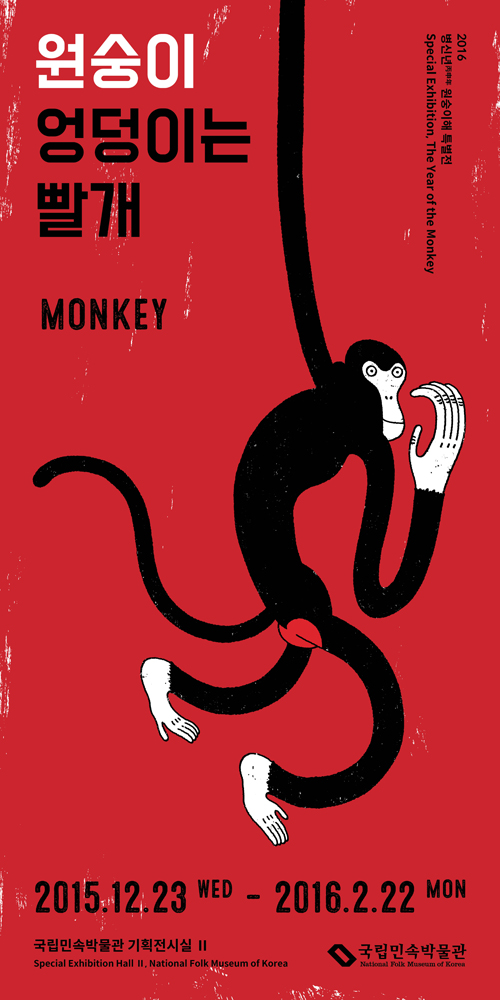The special exhibition "Monkey" was curated to introduce the symbolic meanings of the monkey in Korean culture in celebration of 2016 Year of the Monkey, also called Byeongshin Year.
Monkeys are similar in their appearances and behaviors to humans and very clever as well. As seen in the first line of a favorite children's song, we are well aware of the appearance and characteristics of monkeys and also familiar with diverse types and names of monkeys. Unlike neighboring countries such as China and Japan, Korea is not a habitat of monkeys. However, Koreans were familiar with this particular animal as it occupied a special position in their everyday lives as a guardian animal of tombs, one of twelve zodiac animal deities, an animal with special skills and one that symbolized good luck for success, motherhood and expelling evil spirits.
National Folk Museum of Korea with the collaboration of Seoul Grand Park Zoo in Seoul Grand Park review how the monkey's behaviors and characteristics are expressed and embedded into our everyday lives; and present these findings to the exhibition.
We wish you a happy and talented Monkey New Year!

Different Names of Monkeys
Monkeys of various types live in diverse habitats around the planet. Their distinct physical characteristics and habitats are reflected in their names, such as the old world monkey, the gibbon and the Japanese macaque. In literature, including the Chinese character dictionary, there are various Chinese letters that refer to monkeys, including 猿원 and 猴후. The character "猿원" was widely used in Korea, while the character "猴후" in China. Monkeys were originally called Jannabi in Korea until the 18th century, and have been called Wonsungi ever since.
Monkey, the 9th of the Zodiac Animals
The monkey is the ninth animal of twelve zodiac animal deities. Twelve animals serve as gods expelling evil spirits in each time and direction. The monkey is the deity of west-southwest direction and the hours from 15:00 to 17:00.
It seems that the idea of twelve zodiac animals was first developed in ancient China. In Korea, twelve animals served as guardians to protect tombstones and Buddhist law after the Silla period, and positioned deeply into daily lives of Korean in combination with folk beliefs.
Monkey, an Auspicious Animal
Monkeys are similar to humans in their appearance. They are very clever and love their children very much. Characteristics derived from physical body and behaviors of monkeys were widely used in painting, stationery and pottery while symbolizing good fortune. In some fables and proverbs, monkeys are described as careless, stupid animals.
Success and Longevity
The Chinese character referring to a monkey, ‘猴후,' has the same pronunciation as the character referring to the position of a public official, '侯후.' That is why people adopted patterns of monkeys in stationery items, such as inkstones and water containers and painted monkeys wishing for success. Monkeys were also painted with deer and peaches to pray for luck and longevity.
Motherhood
Monkeys are attentive caretakers of their children. Their sense of motherhood is well described in the old story of "a mother monkey whose insides were cut into pieces." Monkeys also symbolize family affection, as they live in close-knit groups.
Expelling Evil Spirits
Monkeys were also believed to ward off evil spirits. Their red faces symbolize Yang energy which protects from evil spirits, so monkeys are widely used in Talchum (Korean mask dance). In the novel "Seoyugi" from China's Ming dynasty, Son Okong who guards Samjangbeopsa, was made into a clay doll and installed on roofs to guard against evil spirits.
A Talented Animal
Monkeys are highly intelligent and clever. These traits are described in various stories. Monkeys are also depicted as skillful and talented animals that mimic human beings in Bongsantalchum (a traditional mask dance drama of Bongsan region).



